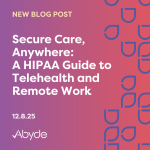June 5, 2025
When ensuring your patients have clear, healthy skin, you might not realize the thorough administrative requirements your practice needs to follow.
HIPAA, or the Health Insurance Portability and Accountability Act, must be upheld by all Healthcare providers and their Business Associates (BAs) who handle and transmit Protected Health Information (PHI). PHI is sensitive information about a patient, such as their Social Security Number, birthdate, medical records, and more. If PHI ends up in the wrong hands, the information could easily be misused, making healthcare a prime target for hackers.
For dermatologists, every piece of information related to a patient’s skin condition – from their name and date of birth to their diagnosis, treatment plan, and even before-and-after photos – falls under HIPAA’s umbrella.
Following HIPAA laws doesn’t just protect your practice from fines – it also keeps your patients safe and builds trust.
What is Required for Dermatologists?
There’s a lot more required than just yearly training.
Dermatologists must follow the three HIPAA rules: the Privacy Rule, the Security Rule, and the Breach Notification Rule to be HIPAA compliant.
The Privacy Rule dictates how PHI can be shared, specifically the minimum amount of information necessary to handle transactions. Information should only be shared with staff who actually need access to it. Staff access to PHI must be monitored and removed when staff leave the practice. The Privacy Rule also details patients’ Right of Access, requiring practices to provide health records to a patient within 30 days.
The Security Rule focuses on the technical, physical, and administrative safeguards that must be in place in your dermatology practice and includes the required Security Risk Analysis (SRA).
The SRA is an extensive annual review of your practice’s protective barriers in case a situation were to occur. SRA questions include information about physical alarms and locks your practice might have, and how email is handled in your practice. By addressing any vulnerabilities before a breach occurs, your practice can more easily mitigate risk.
Leaving this document incomplete can have severe consequences. For instance, a dermatology organization without a compliant SRA was fined $250,000 following a breach. The Office for Civil Rights (OCR), which enforces HIPAA, also enacted the Risk Analysis Initiative. This new initiative focuses on and fines practices missing an SRA after being alerted of a breach.
In addition to the SRA, dermatologists must complete Disaster Recovery Plans for their practices. The Disaster Recovery Plan builds a contingency plan in case a natural or man-made disaster, such as flooding or a cyber-attack, occurs.
These documents lead to the policies and procedures your practice must have that are easily accessible to staff. With policies and procedures, everyone in your practice will know what is expected and unacceptable in your organization, mitigating risk and providing a guide for every situation. In addition to this, training is also required under the rule for all new employees and yearly.
Expect an update to the Security Rule soon, and you can find the new details here.
The last rule of HIPAA is the Breach Notification Rule. This rule is observed after a breach, ensuring that all involved parties are properly informed following a breach of PHI.
After a breach of any size, affected individuals must be notified within 60 days of the breach’s discovery. If it is a small breach, the OCR must also be informed by the end of the year.
However, the breach is considered large if more than 500 patients are affected. For large breaches, while patients must be notified within 60 days, the OCR also does. The media must also be notified, with a press release going out. Depending on the state, the Attorney General must be made aware of this, too, so it is vital to review state law as well when facing a breach.
Streamlining Compliance in Your Dermatology Practice
Given the ever-changing nature of the HIPAA landscape, the brief overview of requirements provided here is just a starting point. While it might feel overwhelming, it’s critical to maintain a compliant dermatology practice.
There are options to simplify HIPAA compliance. Smart software can efficiently assist in compliance management. The pillars of HIPAA compliance, such as the SRA, Disaster Recovery Plan, training, documentation, and more, can all be resolved with the right software platform. By using a smart solution, you can proactively pinpoint gaps and stay on top of your compliance management, freeing you up to focus on caring for patients’ skin.
To see how your dermatology practice can streamline HIPAA for your practice, meet with a compliance expert today.


